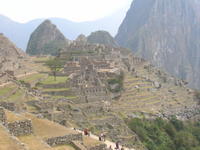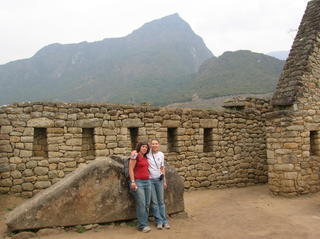Trip to Peru (contd)

Machu Picchu (Sunday):
Finally, the long-awaited day arrived...at 6am, Meg and I boarded a train that took us on a 4-hour long trip to Aguas Calientes.There I was pleasantly surprised to discover that Machu Picchu was located in the semi-tropical zone, which guaranteed a warm day.From there, we had to take a 30-minute bus ride to the actual park along a winding mountain road, which offered not only a breathtaking view of the mountains, but also gave us a peak of the ruins...even from a distance, the ruins looked impressive.
And indeed, Machu Picchu proved to be more that I expected...a whole city of ruins, well-preserved, with tons of interesting history and mistery behind each stone.We decided to forego getting a guide and explore the ruins on our own with the help of a map that showed us all possible tracks.
Our misfortunes began when we, busy taking in the majesty of the ruins and taking pictures, accidentally took a wrong turn and got off the intended track.We found ourselves more and more lost as we went on (by lost I mean being surrounded by ruins, but not knowing what they meant).Our miseries climaxed when we climbed up to a group of ruins, which we later learned was former Inca industrial zone, and found ourselves not being able to climb back down and even getting whistled at by one of the park workers warning us against any kind of mischief (such as jumping off the ruins).Once we found our way back down, we ended up talking to the same worker that whistled at us and learning all sorts of interesting things about the ruins and history behind some of the areas.
FYI: Machu Picchu, or the Hidden City of the Incas, was discovered sometime in the first half of the 20th century by an English (or maybe American) explorer Hiram Bingham who gave the place its current name and named the groups of ruins in it.We were also surprised to find out that Machu Picchu is actually the name of one of the mountains surrounding the park and was given to Bingham by the locals when he first arrived there.In Quechua it means Old Mountain...on the other side of the ruins, there is a mountain called Hyana Picchu, or Young Mountain.
Based on the history and details of the ruins, Machu Picchu (the park) used to the an important religious site for the Inca Empire. The Incas had a calendar of 365 days and were able to tell seasons of the year.Their civilization was very advanced, and their religious beliefs were based on astronomy and the objects of nature around them (water, mountains, etc).
We were also lucky to see some more of my beloved llamas just walking around the ruins...I was glad that Meg got to pet one. The train ride back to Cusco was very enjoyable as our attendants put on a costume show displaying the clothes made out of the fiber of baby alpaca.
The picture above is of the view of the park, and below are some shots of Meg and I among the ruins.



0 Comments:
Post a Comment
<< Home